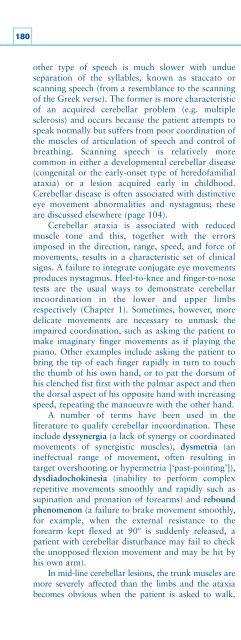Create successful ePaper yourself
Turn your PDF publications into a flip-book with our unique Google optimized e-Paper software.
180other type of speech is much slower with undueseparation of the syllables, known as staccato orscanning speech (from a resemblance to the scanningof the Greek verse). The former is more characteristicof an acquired cerebellar problem (e.g. multiplesclerosis) and occurs because the patient attempts tospeak normally but suffers from poor coordination ofthe muscles of articulation of speech and control ofbreathing. Scanning speech is relatively morecommon in either a developmental cerebellar disease(congenital or the early-onset type of heredofamilialataxia) or a lesion acquired early in childhood.Cerebellar disease is often associated with distinctiveeye movement abnormalities and nystagmus; theseare discussed elsewhere (page 104).Cerebellar ataxia is associated with reducedmuscle tone and this, together with the errorsimposed in the direction, range, speed, and force ofmovements, results in a characteristic set of clinicalsigns. A failure to integrate conjugate eye movementsproduces nystagmus. Heel-to-knee and finger-to-nosetests are the usual ways to demonstrate cerebellarincoordination in the lower and upper limbsrespectively (Chapter 1). Sometimes, however, moredelicate movements are necessary to unmask theimpaired coordination, such as asking the patient tomake imaginary finger movements as if playing thepiano. Other examples include asking the patient tobring the tip of each finger rapidly in turn to touchthe thumb of his own hand, or to pat the dorsum ofhis clenched fist first with the palmar aspect and thenthe dorsal aspect of his opposite hand with increasingspeed, repeating the manoeuvre with the other hand.A number of terms have been used in theliterature to qualify cerebellar incoordination. Theseinclude dyssynergia (a lack of synergy or coordinatedmovements of synergistic muscles), dysmetria (anineffectual range of movement, often resulting intarget overshooting or hypermetria [‘past-pointing’]),dysdiadochokinesia (inability to perform complexrepetitive movements smoothly and rapidly such assupination and pronation of forearms) and reboundphenomenon (a failure to brake movement smoothly,for example, when the external resistance to theforearm kept flexed at 90º is suddenly released, apatient with cerebellar disturbance may fail to checkthe unopposed flexion movement and may be hit byhis own arm).In mid-line cerebellar lesions, the trunk muscles aremore severely affected than the limbs and the ataxiabecomes obvious when the patient is asked to walk.With a cerebellar lesion, the patient walks with a broadbase in order to maintain his balance. Often this is bestdemonstrable when a patient is asked to turn suddenly,when they tend to sway, reel to either side, or fallbackwards. This is especially so with lesions in thecerebellar vermis. In less severe cases, as the patientturns on a wide base they abduct their lower limbsexcessively to compensate for hypotonicity and thenreplace the foot on the ground away from the intendedposition (due to dysmetria). This results in the typicaldecomposition of gait seen in cerebellar disorders.Because such clumsiness is not corrected by vision(unlike the patient with a posterior column disease), apatient with cerebellar ataxia does not look to theground while walking but instead looks straight ahead.In pure cerebellar lesions uncomplicated by centralnervous system involvement at other sites, reflexes arenot overtly affected but the tendon jerks may be mildlyaffected qualitatively. When the knee jerk is tested withthe patient sitting at the edge of the bed, the knee mayswing back and forth three times or more due to acombination of muscle hypotonia and reboundphenomenon. This is known as a pendular knee jerkand must not be interpreted as a sign of pathologicalhyperreflexia associated with corticospinal lesions.Testing for joint position sense and vibration iscovered elsewhere in the book (Chapter 1). Patientswith sensory ataxia may have muscle hypotonia anddiminished reflexes when the pathological process isat the level of the peripheral nerves, dorsal rootganglia or, rarely, in the posterior column withoutextending into the corticospinal tracts. Inuncomplicated sensory ataxia, the patient walks on abroad base in order to maintain their centre ofgravity. Limbs are lifted abnormally high due to theinability to appreciate the normal range ofmovements at the joints as a result of lack ofproprioception. For the same reason, the heels areslammed back to the ground with excessive force,resulting in a ‘stamping’ gait, originally describedwith tabes dorsalis (literally meaning wasting of theposterior column), a form of neurosyphilis. Acombination of proprioceptive loss, painless jointdeformity (Charcot joints), and perforating ulcers ofthe lower limbs was virtually diagnostic of thelocomotor ataxia of neurosyphilis, a condition that isnow seldom seen but contributed a great deal to theunderstanding of sensory ataxia. In patients withsensory ataxia, the heels of the shoes tend to get wornmore quickly as this part of the foot strikes theground with so much force.
















